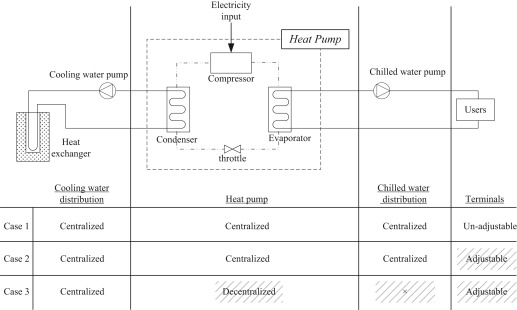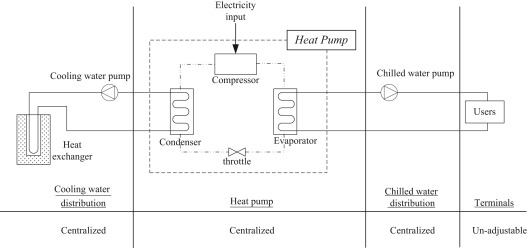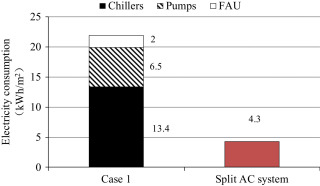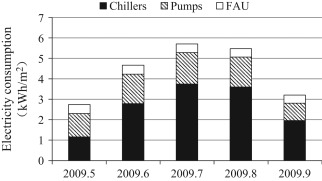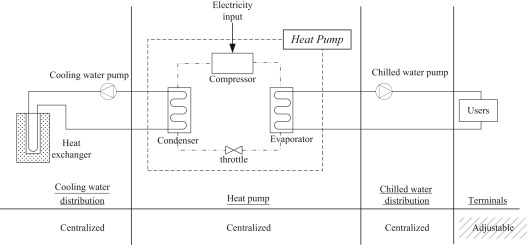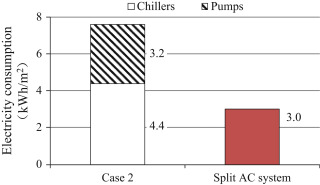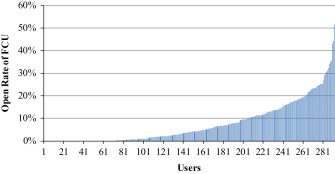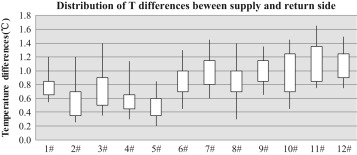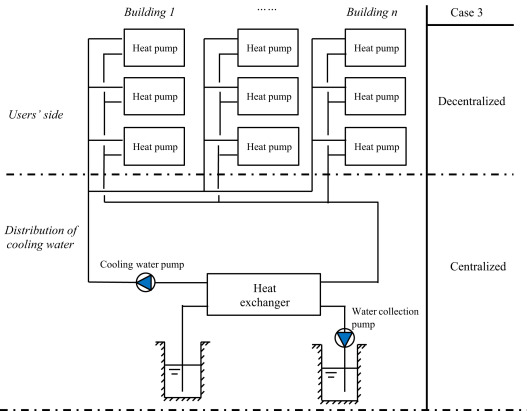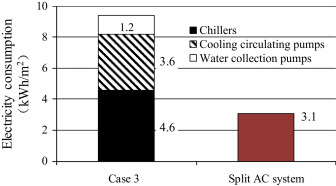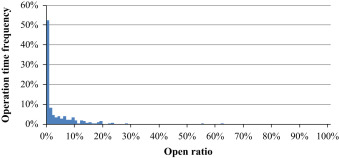Abstract
Two types of air conditioning (AC) systems generally exist, namely, centralized and decentralized AC systems. This study focuses on three actual engineering projects of residential communities where centralized AC systems are adopted. The applicability of centralized AC systems in residential buildings is discussed and analyzed. In addition, the key elements that lead to different building energy consumptions and system efficiencies between centralized and decentralized AC systems in residential buildings are investigated. This study shows that in residential buildings, at the point where the centralized feature of the system meets the decentralized feature of users’ load, the problems of high energy consumption and low energy efficiency could easily occur.
Keywords
Residential buildings ; Centralized AC system ; Decentralized AC system ; Comparative research
1. Introduction
As a typical representation of a decentralized air conditioning (AC) system, the split-type air conditioner has been used in a majority of residential buildings in China for a long time. Recently, centralized AC systems have also appeared in residential buildings, and they are approved and supported by specific government policies (Zhang et al., 2009 ). Centralized AC systems reflect advanced and efficient energy usage. They consume less energy with better service; therefore, the development of future indoor environment control in residential buildings should take centralized AC systems into consideration (Aste et al., 2013 ). One of the main advantages of centralized AC systems is that they can satisfy the cooling requirements for multiple buildings at the same time (Chow et al., 2004b ). In addition, they use refrigeration equipment with large capacity and high efficiency. Centralized AC systems also require lower power compared with split AC systems (Chow et al ., 2004c ; Shimoda et al ., 2008 ; Soederman, 2007 ; Jordi et al ., 2013 ). Moreover, for the usage of renewable energy sources, such as underground water or seawater, influenced by the type of cooling source, centralized cooling systems are simpler and less expensive (Rezaie and Rosen, 2012 ; Chow et al ., 2004a ). From an energy usage point of view and considering urban landscape, centralized AC systems are effective and should be promoted.
However, in some respects, decentralized AC systems are more advantageous than centralized systems. With a decentralized AC system, users have greater flexibility in controlling the AC terminals according to their requirements. Under this type of control method, the cooling energy supplied by the AC system would be reduced effectively (Li and Jiang, 2009 ). Moreover, no distribution system exists in decentralized AC systems, which means that the total energy consumption would not include the consumption of fans or pumps. Therefore, from the above analysis on system types, both centralized and decentralized AC systems have their own advantages. From the comparison, the centralized and decentralized AC systems can be concluded to represent two entirely different AC concepts.
As Fig. 1 shows, many studies (Li and Jiang, 2009 ; Hu et al ., 2004 ; Ren et al ., 2003 ; Long et al ., 2003 ; Wu, 2005 ; Chen et al ., 2008 ; Ma et al ., 2007 ; Li, 2012 ; Building Energy Research Center in Tsinghua University, 2013 ; Sun, 2006 ) have been conducted to examine the energy consumption in residential buildings in different districts of China. From the comparison, the annual energy consumption of centralized AC systems is observed to be higher than that of decentralized systems in general. The largest difference between the energy consumption of the two systems could be greater than 10 times.
|
|
|
Fig. 1. Comparison of annual energy consumption for decentralized and centralized AC systems in residential buildings. |
Thus, the theoretical analyses of district cooling systems differ greatly from the actual operating experience in many cases, and some important factors that lead to the large differences in energy consumption between centralized and decentralized AC systems have been ignored. To analyze the reason for the energy differences between these AC systems, three actual engineering projects in residential buildings with different types of centralized AC systems were considered in this study. The applicability of centralized AC systems in residential buildings is analyzed and discussed, and the key elements that influence the energy consumption differences between centralized and decentralized AC systems in the case studies are explored.
2. Methodology
The basic information of the three actual cases is graphically explained in Fig. 2 . Centralized AC systems are applied in all the three cases; however, the levels of centralization are relatively different.
|
|
|
Fig. 2. Research cases. |
AC systems can be considered as three heat transfer segments, namely, (1) the heat transfer process between AC terminals and indoor environment, (2) the chilled water heat distribution process between refrigerating machines and AC terminals, and (3) the cooling water heat distribution process between refrigerating machines and the cooling side. In the segment of the heat transfer process between the AC terminals and indoor environment, users in Case 1 cannot adjust the AC terminals; however, in Cases 2 and 3, users can turn the AC terminals on or off according to their requirements. In the segment of the chilled water heat distribution process between the refrigerating machines and AC terminals, in Cases 1 and 2, all cooling energy consumptions are centralized to the cold site and processed by a unified refrigeration equipment with large capacity, while in Case 3, household heat pump systems are applied, and the heat pumps are distributed in each family. Given the different types of refrigeration equipment, the types of chilled-water distribution systems are also different. In Cases 1 and 2, the chilled water is supplied uniformly from refrigeration plants to each AC terminal, while in Case 3, no chilled-water distribution process exists. In the segment of the cooling water heat distribution process between refrigerating machines and the cooling side, all three cases use underground water as the cooling source, and the cooling water is collected together for heat dissipation. In Case 3, however, the cooling water is circulated between the underground cooling source and the heat pump in each household. Thus, the three cases can be summarized as follows:
- Case 1: centralized refrigerating machines and distribution system of chilled water and cooling water; users cannot adjust the AC terminals;
- Case 2: centralized refrigerating machines and distribution system of chilled water and cooling water; users can adjust the AC terminals;
- Case 3: decentralized refrigerating machines, centralized distribution system of chilled water and cooling water; users can adjust the AC terminals.
Obtaining direct access to all three types of actual projects is difficult; therefore, we seek assistance from other researchers. Case 1 (Li, 2012 ) and 3 (Sun, 2006 ) have been analyzed in previous studies, and the details of energy data are sufficient for our analysis. For Case 2, we conducted field measurements in the community to obtain the primary data for our study. The data collection procedure for each case study is as follows:
- Case 1: A metering system that records the cooling energy consumption by the community and the electricity consumption of the AC equipment (such as chillers, pumps, and fans) was installed in the AC system.
- Case 2: An AC unit metering system that records the on/off state and the daily runtime of the fan coil unit (FCU) was installed in the community. The cooling energy consumption was obtained from the property management company in the residential community. Data (chilled-water flow rate from each building, supply and return water temperatures for each building, chiller flow rates, chiller supply and return water temperatures, and electrical power to the chillers and pumps) were recorded every 10 min in the district cooling system from July to September 2011. The energy consumption and system efficiency were then calculated based on these measurements.
- Case 3: Detailed measurements on the AC system in the community were obtained, including the cooling consumption and the electricity consumption of chiller and pumps. Moreover, the supply and return water temperatures of the AC system were recorded.
In the following discussions, the energy consumption of each segment and the reason for the high-energy consumption of the centralized AC systems in residential buildings are analyzed based on the measured data.
3. Survey and measurement
3.1. Case 1: centralized chillers and distribution system; users cannot adjust terminals
Case 1 is in a residential community in Jiangsu Province (Li, 2012 ). The community has 10 residential buildings, and the total building area is 114,000 m2 . The community includes 1200 households, while the occupancy ratio is approximately 90% at the time of measurement.
The system diagram of Case 1 is shown in Fig. 3 . The AC terminals in this community adopt ceiling panel radiation and displacement ventilation systems to meet the requirements of temperature and relative humidity. Ground-coupled heat pump units are chosen as the cooling source. Variable speed pumps are employed on the cooling-water and chilled-water sides. The design cooling load of the ceiling panel radiation system is 1757 kW, and two heat pumps are installed with unit number control.
|
|
|
Fig. 3. System diagram of Case 1. |
The typical totally centralized AC system is adopted in this residential community. The chilled water collects the cooling consumption at the users’ side together and brings it to the heat pumps to achieve unified management. On the users’ side, the cooling utility is charged by area. Each space in the buildings, including the corridors, washrooms, and empty rooms, is controlled 24 h a day according to a predetermined temperature and humidity standard to maintain the comfort requirement (24 °C dry-bulb temperature) in every room all the time. Therefore, the service concept in this community is centralized AC control. However, under this type of control mode, the adjustability of the indoor environment by the users is considerably limited. For example, in this community, users cannot open the windows to get fresh air, and the AC terminals cannot be closed by the residents.
The energy consumption of the AC system in this community under this type of service is shown in Fig. 4 . The split AC system is taken as the typical representative of a decentralized AC system, and its consumption is also shown in Fig. 4 for comparison. The electricity consumption of the split AC system is obtained from actual measurements of 780 households in Shanghai. The average electricity consumption is 4.3 kWh/m2 (Long et al., 2003 ). Owing to the similarity of the climate in Jiangsu and Shanghai, the energy consumptions of the split AC systems in the two districts are considered similar. From the comparison, the electricity consumption of the AC system in this residential community is approximately five times that in the split AC system in a similar district.
|
|
|
Fig. 4. Electricity consumption of AC system in Case 1. |
The analysis of the measurements and survey results indicates that the main reason for the high AC consumption in this community is that under this type of system, namely, the non-adjustable feature for users, the AC operation mode is full time and full space. Under this type of operation mode, the operating time and space of the AC system under full load is considerably higher than that of the split AC system. Under the centralized AC system in Case 1, the product of the service area and service time of the AC is 114,000 m2 ×24 h, which is equal to 2,740,000 m2 h. When the split AC system is adopted, the product of the service area and service time is approximately 684,000 m2 h, which is only 25% of that in Case 1 (Building Energy Research Center in Tsinghua University, 2013 ). The efficiency of the heat pump equipment itself is high, and the average COP in the cooling season is 4.4. However, with the large requirement of cooling consumption in the terminal sides, the electricity consumption of the heat pump itself is approximately two times that in the split AC systems.
Unlike split AC systems, the centralized AC system includes the electricity consumption of water pumps and fans. According to system operation records from May to September 2009, the monthly electricity consumption of chillers, water pumps, and fresh air units is calculated as shown in Fig. 5 . The proportion of electricity consumption for water pumps and fans in each month ranges from 30% to 60%, which is approximately 0.5 to 1.4 times the chiller consumption. Therefore, the electricity consumption of the distribution system is a main contributing part in the AC system and is a major factor in the high AC consumption in this residential community.
|
|
|
Fig. 5. Composition of AC system׳s monthly energy consumption. |
The electricity consumption for each part of the centralized AC system in Case 1 is listed in Table 1 . The efficiency of the entire AC system is equal to the users’ cooling consumption divided by the sum of the electricity consumption of the heat pumps and water pumps. Through calculation, we can obtain the system efficiency of this AC system in Case 1, which is 3.0. This value is higher than the typical efficiency of split AC systems (2.5). However, in Case 1, the operation mode is full time and full space, and the AC terminals are non-adjustable. The actual cooling consumption of users in this residential community is more than five times that with the split AC systems in the same district. Under high cooling requirement, the electricity consumption of the centralized AC system operation in Case 1 is significantly higher than that of split systems, and the distribution system consumes approximately 33% of the total electricity consumption. With the two affecting elements, notwithstanding the high efficiency of heat pump itself and the entire AC system, the electricity consumption of the AC system in Case 1 is approximately five times the consumption when split AC systems are adopted in the same district.
| Distribution of cooling water | Heat pump energy consumption | Distribution of chilled water | Cooling consumption | |
|---|---|---|---|---|
| Case 1 | 2.5 kWh/m2 | 13.4 kWh/m2 | 4 kWh/m2 | 59 kWh/m2 |
3.2. Case 2: centralized chillers and distribution system, users can adjust terminals
Case 2 is in a residential community in Henan Province. The community covers an area of 27,944 m2 with a habitable floor area of 41,200 m2 . The community has 12 buildings with 294 households, and each building has five floors. The occupancy rate is 75%. Two screw water source heat pump units with cooling capacities of 1463 and 542 kW, separately, are taken as the central AC equipment. The pumps in the water system are constant-speed; the pumps include two circulating pumps and two submersible pumps. The submersible pumps work under the water to pump the water up. The main equipment is listed in Table 2 . The FCUs are taken as AC terminals with no control on the waterside. In this community, users are charged for the cooling consumption according to the operation situation of the FCU terminals, i.e., the cost of cooling consumption is based on the measured operating hours of fan coils under high, middle, and low speeds. When the AC terminal is closed, no cooling fees would be charged.
| Equipment | Rated parameters |
|---|---|
| Heat pump 1# | Rated cooling capacity: 1463.6 kW, rated cooling power: 226.0 kW |
| Heat pump 2# | Rated cooling capacity: 542.4 kW, rated cooling power: 89.7 kW |
| Chilled water pumps | Rated flow rate: 190 m3 /h, pump head: 38 m, rated power: 27 kW |
| Cooling water pumps | 1#, 2# rated power: 37 kW; 3#, 4# rated power: 22 kW |
The configuration of the AC system in Case 2 is similar to that in Case 1, as shown in Fig. 6 . However, in Case 2, the AC terminals are the FCUs, and users can choose different fan speeds to adjust the indoor environment according to their requirements. Moreover, the AC terminals can be closed to stop the AC supply in some rooms. Therefore, the adjustability of this type of AC terminals is similar to that of the split AC system. As previously mentioned, in this community, the charging method is based on the operating hours of the AC terminals, which encourages the users to turn off the AC when not required. However, for the centralized refrigerating machines and the constant-flow operation mode of the chilled-water system, the electricity consumption of the chilled-water pumps takes a larger proportion of the total energy consumption.
|
|
|
Fig. 6. System diagram for Case 2. |
In Case 2, the measured result of the users’ cooling consumption during the cooling season is 7.5 kWh/m2 . Under the AC system in Case 2, the adjustability of the AC terminal is similar to that of the split AC system; thus, the cooling consumptions in the two types of AC systems are assumed to be similar. Through a simulation, it can be calculated that if the totally centralized AC system (like the full time and full space operation mode in Case 1) is applied for the community in Case 2, then the cooling consumption would increase to 54.0 kWh/m2 , which is approximately seven times the actual existing cooling consumption. Therefore, when users can adjust the AC terminals freely and a reasonable charging method is applied, the cooling requirement of the users would be reduced greatly compared with that in Case 1.
When the split AC system is applied in this residential community, the cooling consumption is expected to be the same as the actual cooling consumption in Case 2. With an average COP of split AC systems of 2.5, then we can calculate that when the split AC system is adopted, the electricity consumption of the AC system is 3.0 kWh/m2 . This result is compared with the actual situation, as shown in Fig. 7 , and the electricity consumption of the AC system in Case 2 is observed to be more than twice that in the split AC system.
|
|
|
Fig. 7. Electricity consumption of AC system in Case 2. |
Fig. 8 shows the service time proportion of the FCU terminals, which is equal to the total operating time in each household divided by the total number of FCUs in the community and the operation hours of the heat pump. The operation data of the household FCUs are obtained from the household cooling consumption meter system. Results show that nearly 80 households did not open the FCU terminals during the observation period, and more than one-third of the users indicated the use of FCU terminal service time at less than 10%. The calculation showed that the average proportion of the FCU terminal service time of this residential community during the entire cooling season is only 7%.
|
|
|
Fig. 8. Proportion of FCU terminal service time from July 1–20, 2011. |
Under this AC terminal operation mode, the contemporary usage ratio of the AC is low, which resulted in a low load ratio of the entire residential community. With the small load ratio, the efficiency of the entire AC system is extremely low. The system efficiency in Case 2, which is equal to the total cooling consumption divided by the total electricity consumption, is approximately 1 (7.5/7.6). The main reasons for this low system efficiency are as follows:
- On the one hand, as mentioned above, under the part time, part space AC operation mode in this residential community, the load ratio of the entire system is relatively low. Only few users have high cooling load requirements, while majority of users have low or no cooling load requirements. Therefore, most of the time, only few fan coils would operate in the AC system. However, the water system has a constant flow rate; the water system would work under a situation with large water flow rate and small differences between the supply and return water temperature. As Fig. 9 shows, during the entire cooling season, the chilled-water temperature difference between the supply and return side of each building is only approximately 1 °C. Therefore, the electricity consumption of the water pumps occupies a larger proportion. The electricity consumption of the water pumps can account for 42% of the total electricity consumption.
|
|
|
Fig. 9. Chilled-water temperature differences between supply and return side of each building. |
- On the other hand, because of the low cooling load requirement in the community, the heat pumps work under low load ratio for a long time. The COP of the heat pumps is considerably lower than the rated value of 6.4. During the entire cooling season, the average COP of the heat pumps is only 1.7, and the system efficiency of the entire AC system is only 1. However, even if the COP of the heat pump can reach the rated value of 6.4, the system efficiency can increase to 1.72 only. The improvement of system efficiency is limited by the electricity consumption of water pumps. From these analyses, the electricity consumption of the water pumps can be concluded to be the main factor that limits the increase in the system efficiency of the entire AC system.
In conclusion, through the analysis of Case 2, when users have the ability to control the AC terminals, the cooling consumption from the users’ side would reduce greatly compared with the centralized AC system in Case 1. Influenced by the system type, the electricity consumption of the AC system in Case 2 includes the electricity consumption of the water pumps. With the constant flow rate operating mode of the water system, the electricity consumption of the water pumps becomes the main contributor to the total AC consumption and is also the main reason for the low system efficiency.
3.3. Case 3: decentralized AC system, centralized distribution system; users can adjust the AC terminals
Case 3 is in a residential community in Beijing (Sun, 2006 ). The community has three residential buildings with 368 households, and the total cooling area is 70,000 m2 . The distributed water loop heat pump system is adopted as the AC system, and the design cooling load is 64 W/m2 . As shown in Fig. 10 , the AC system includes a centralized underground water circulating system and a decentralized heat pump system. The underground water is lifted by a deep-well pump. After heat exchange, cooling water is supplied to the heat pump in each household through the loop pipe network. The heat pump is distributed in each household. To satisfy the cooling requirement, the circulating pumps operate 24 h a day continuously under a constant flow rate. The cooling water pump and water collection pump are variable-speed.
|
|
|
Fig. 10. System diagram of Case 3. |
An all-air system is taken as the AC terminal in this community. Air ducts are installed in each room, and no control valve exists in the air inlet. Therefore, when a cooling requirement exists in a room, all rooms in the household would be cooled. In contrast to the two cases above, the heat pump is set in each household in Case 3, and the heat pump can be turned on or off according to the requirement. Thus, the operation mode is part time, full space. In Case 3, the AC system still has a centralized feature, i.e., the cooling water circulates uniformly, and the AC terminals in each household are controlled uniformly. Users will pay for the electricity consumption of heat pumps, and a portion of other consumptions is charged based on the area of the household.
Researchers have obtained the average electricity consumption of the split AC system as applied in China. The average value is 3.1 kWh/m2 in residential buildings in Beijing (Li, 2006). The electricity consumption of the AC system in the residential community in Case 3 is approximately three times that in the split AC system, as shown in Fig. 11 . Considering the average COP of the split AC system as 2.5, the average cooling consumption of the split AC system in residential buildings in Beijing is approximately 7.8 kWh/m2 . The measured cooling consumption in Case 3 is 13.2 kWh/m2 . Therefore, under this type of system, the cooling consumption is higher than that of the split AC system. The main reason for this finding is that under the split AC system, the usage mode is part time and part space, while in Case 3, which is influenced by the AC terminals, the usage mode is part time and full space.
|
|
|
Fig. 11. Electricity consumption of AC system in Case 3. |
During the entire cooling season, the average COP of the heat pumps is 2.9, which is higher than that of the split AC system. However, in Case 3, all the water pumps are turned on for the entire day irrespective of the number of heat pumps under operation. Only the circulating pumps have an electricity consumption of 3.7 kWh/m2 . Table 3 shows the average result of the temperature measurement during the entire cooling season. The measured result of cooling water temperature differences indicates that the water system is under a situation with large water flow rate and small differences between the supply and return water temperatures as shown in Table 3 . Under this operating situation, the consumption by the water pumps becomes the main composition of the total electricity consumption, which can be observed in Fig. 11 . In this cooling water centralized AC system, the electricity consumption of water pumps is approximately half of the total consumption. Therefore, the electricity consumption of AC system is higher than that of general split AC systems.
| Tsupply | Treturn | Tdifferences | ||
|---|---|---|---|---|
| Design value | 18 | 32 | 14 | |
| Measured data of each year | 2003 | 25.8 | 26.5 | 0.7 |
| 2004 | 27.9 | 28.5 | 0.6 | |
| 2005 | 27.0 | 27.8 | 0.8 | |
In conclusion, Case 3 shows that under a cooling supply mode of part time and full space, the cooling requirement of users would be less than that of the total centralized AC system (Case 1); however, it is higher than the cooling consumption under the part time and part space service mode. In Case 3, the system adopts a decentralized heat pump, which ensures that the heat pumps can work under a high load ratio; therefore, the operating performance of the heat pumps is improved. However, the cooling water system is centralized, and the electricity consumption of the cooling water distributed system becomes the main part of the total consumption. The electricity consumption of the cooling water pumps is approximately 51% of the total electricity consumption of the AC system.
4. Analysis and discussion
The three case studies discussed above all adopt centralized AC systems; however, they are different in the users’ ability to control the AC terminals, type of refrigeration equipment, and form of distribution system. Taking the three cases together and performing a comprehensive comparison will enhance the understanding of the applicability of centralized AC systems in residential buildings. For the differences in thermal load, service area, and room temperature, among others, comparing the energy consumption of the three cases directly is not appropriate. Therefore, in this study, we focus on the characteristics of each case, and only the ratios of each energy consumption part are compared.
The composition of the electrical and cooling consumption in the three cases is listed in Tables 4 and 5 lists the energy efficiency of each segment. The calculation method of energy efficiency is based on the requirement in the Chinese standard for “economic operation of AC control system”. The COP is equal to the cooling consumption divided by the electricity consumption of the heat pumps; the transport coefficient of chilled water (TCchw ) is equal to the cooling consumption divided by the electricity consumption of chilled-water pumps, while the transport coefficient of cooling water (TCcdp ) is equal to the cooling consumption divided by the electricity consumption of cooling water pumps; the system efficiency is equal to the cooling consumption divided by the sum of the electricity consumption of heat pumps and water pumps. The electricity consumption is the sum of the consumptions of all components (cooling water pumps, chilled-water pumps, and heat pumps). Through the comparison and analysis, the main conclusions from the three study cases are as follows:
- If a condition for independent adjustment exists, then users would adjust the AC terminals according to the operation of the split AC system. The cooling load would exhibit features of desynchrony and low load ratio.
In cold and extremely cold areas, the cooling and heating loads in residential buildings have different characteristics. During the heating season, the heating load is mainly influenced by the outdoor climate; thus, the heating loads of different users are synchronous. However, during the cooling season, the internal heat gain becomes the main influencing element of the cooling load, thereby resulting in different characteristics of heating and cooling loads.
Apartment is the main building type in Chinese residential buildings. The following are the main features of the operation mode in apartments: (1) the occupancy situation differs among different households; (2) the number of people in the household changes substantially; (3) the requirements of indoor environments have large discrepancies. With these features, if users could control the AC terminals freely, then they would operate the AC part time and part space, and the operation mode results in the load feature of desynchrony and low load ratio in residential buildings.
Through the comparison, we can find that in totally centralized AC systems, the full time and full space indoor environment control service (Case 1) results in the highest electricity consumption. The energy consumption in Case 1 is approximately three times that in the situation where the AC terminals can be controlled freely (Case 2).
The service mode is one of the most important factors that affect the differences in energy consumption. In Case 1, the cooling consumption is 59 kWh/m2 , which is five times higher than that in Cases 2 and 3. In Case 1, no matter what the cooling requirement is, the indoor environment is controlled according to the predefined standard of comfort, i.e., the full time and full space indoor environment control mode. In Case 3, the household centralized AC system is adopted, and the service mode is part time and full space. In this case, the cooling consumption is 13.2 kWh/m2 , which is lower than that in Case 1. In Case 2, the control of AC terminals is similar to that in split AC systems, and users can control the AC terminals according to their requirements. Under this type of control mode, influenced by the lifestyle, most residents in China would select the part time and part space operating mode. Therefore, the cooling consumption in Case 2 is lower than that in Cases 1 and 3. For example, the bedroom in a household will be occupied during only 30% of the day, and the residents prefer to close the air conditioner after they fall asleep. Thus, the air conditioner is opened in the bedroom for only approximately 20% of the day. However, the same bedroom in Case 1 would be air conditioned all day long; therefore, the cooling consumption would be considerably higher than the actual requirement. Under this type of service mode, the factor of service time and space is almost five times that in split AC systems.
- In residential buildings, influenced by the requirement of user terminals, the distribution energy consumption becomes the main component of the system consumption in centralized AC systems.
| Distribution of cooling water | Heat pumps | Distribution of chilled water | Cooling consumption | |
|---|---|---|---|---|
| Case 1 | Centralized | Centralized | Centralized | Un-adjustable |
| 2.5 kWh/m2 | 13.4 kWh/m2 | 4 kWh/m2 | 59 kWh/m2 | |
| Case 2 | Centralized | Centralized | Centralized | Adjustable |
| 1.7 kWh/m2 | 4.4 kWh/m2 | 1.5 kWh/m2 | 7.5 kWh/m2 | |
| Case 3 | Centralized | Decentralized | – | Adjustable |
| 4.8 kWh/m2 | 4.6 kWh/m2 | 13.2 kWh/m2 | ||
| Transport coefficient of cooling water | COP of heat pumps | Transport coefficient of chilled water | System efficiency | Electricity consumption (kWh/m2) | |
|---|---|---|---|---|---|
| Case 1 | 29.0 | 4.4 | 14.8 | 3.0 | 21.9 |
| Case 2 | 7.0 | 1.7 | 5.0 | 1.0 | 7.6 |
| Case 3 | 3.7 | 2.9 | – | 1.4 | 9.4 |
In Cases 2 and 3, the control of AC terminals possesses the feature of that in split AC systems; however, the refrigerating machines and distribution systems are conventional types in centralized AC systems. In Cases 2 and 3, the energy consumption of the AC system is approximately 8 kWh/m2 , which is approximately 1.5 to 3 times those in decentralized AC systems.
This difference in energy consumption is mainly caused by the distribution energy consumption in Cases 2 and 3. Table 5 indicates that the transport coefficient of chilled water and cooling water cannot exceed 10. In Case 3, the transport coefficient of chilled water is only 3.7. According to the stipulation in the Chinese standard for “economic operation of air-conditioning control system,” when the annual working condition is evaluated, the lower limit value for TCchw and TCcdp is 30 and 25, respectively. Therefore, in Cases 2 and 3, the transport coefficients of the pumps are extremely low.
As mentioned above, in Cases 2 and 3, the cooling consumptions do not differ considerably from those in decentralized AC systems. However, the circulating pumps in the distribution systems operate continuously for 24 h; thus, most of the time, the efficiency of distributing the cooling consumption is low. For example, in Case 2, during the cooling season, the circulating pump electricity consumption alone is 3.2 kWh/m2 , and this value is equal to the average electricity consumption of the split AC system in summer in that area. Case 3 can explain the phenomenon further. In Case 3, only the cooling water is circulating in the system. With the ability to control the AC terminals, residents will take the control mode of part time and part space; thus, the operating time of the heat pumps will be reduced considerably. From the results in Case 3, the electricity consumption of heat pumps and terminal equipment is only 48%, and the electricity consumption of cooling water pumps is more than half of the total consumption.
If electric on/off valves are installed in the users’ side, and the water pumps use frequency conversion control in Cases 2 and 3, then the water temperature differences of the chilled-water system can be increased, thereby reducing the distribution system׳s energy consumption in the centralized system to a certain extent. However, with desynchrony and low load ratio feature of the cooling load in residential buildings, the energy consumption of the distribution system will still be a major component of the total consumption. Taking Case 2 as an example, Fig. 12 shows the statistical result of each household׳s AC terminal operating time frequency on July 4. The majority of users’ operation ratio of FCU terminals is within 10%, and only a few users’ operation ratio reaches 60%. Under this situation, the most ideal control mode of the water system is that many circulating pumps are installed using parallel operation control, and the operation number and frequency of the water pumps are adjusted according to the water temperature differences. However, in actual engineering cases, in general, the number of pumps would be two to three. Therefore, when the AC terminal operation ratio is low, the water pump operating point would have a serious deviation that will result in high consumption and low efficiency of the distribution system. Meanwhile, the chillers also limit the reduction of the energy consumption of the distribution systems. Centralized AC systems have two to three chillers at most, and each chiller has a minimum flow restriction. Therefore, the flow rate of the distribution system cannot be reduced considerably under low load ratio. Consequently, the system will inevitably operate under a situation with large water flow rate and small differences between the supply and return water temperatures.
|
|
|
Fig. 12. Statistical result of operating time frequency of FUC terminal on July 4 in Case 2. |
If a variable-speed pump control is applied in Case 2, then the electricity consumption of the water pumps can be reduced. However, handling a situation where the cooling consumption is extremely low and unevenly distributed among different households is relatively difficult (as Fig. 8 shows). Other pumping systems, such as primary-secondary and primary-tertiary systems, may mitigate the problem, which requires the introduction of simulation methodology and further analysis.
Therefore, from the above analysis, the main reason for the low system efficiency is that the cooling load in residential buildings exhibits desynchrony and low load ratio, and these features considerably differ from those in public buildings. During the design phase, the engineering load calculation method usually focuses on the peak load for equipment sizing, whereas load diversity is rarely considered. In addition, even when the hourly cooling load is calculated, the internal load and schedule of each household are the same; thus, the disparity due to desynchrony and low load ratio would not be considered.
- In residential buildings, the sections where the centralized feature meets the decentralized feature frequently present high energy consumption characteristics.
From the above analysis, the cooling requirement in residential buildings has the feature of part time and part space. This feature is in conflict with the inherent disadvantage of adjustability in centralized AC systems. In actual applications, when adjustability is limited in AC terminals or distribution systems, the system would frequently present a high energy consumption.
In Case 1, the AC terminals cannot be adjusted, and this is in conflict with the decentralized feature of the cooling load on the users’ side. This contradiction leads to an increase in cooling consumption, which results in the high operation consumption in Case 1.
In Case 2, the AC terminals are adjustable; however, the water system has a constant flow rate, which is in conflict with the users’ decentralized cooling load. Particularly, in Case 2, the heat distribution process of chilled water between the refrigerating machines and AC terminals becomes the contradiction boundary. This contradiction makes the distribution and consumption of chilled-water pumps the main reason for high energy consumption. From Table 5 , the transport coefficient of chilled water in Case 2 is only 5, which is significantly below the standard limit value of 30. The non-adjustability of the chilled-water system influences the adjustability and operating condition of chillers and cooling water systems, thereby resulting in low system efficiency.
In Case 3, the household heat pump system is adopted; therefore, the heat pumps and the indoor heat transfer can be taken in entirety and possess the decentralized feature. However, the cooling water system has a constant flow rate. Consequently, this contradiction makes the electricity consumption of the cooling water pumps the main component of the total consumption. A comparison between Cases 2 and 3, where both heat pumps are adopted, indicates that the electricity of the cooling water pumps in Case 2 is only 20% of the total consumption, while the consumption of the cooling water system in Case 3 is 51%.
Therefore, the comparison of the three cases indicates that when a centralized AC system is applied in residential buildings, increasing the adjustability of each segment to match the decentralized load characteristics is important. If any segment lacks adjustability, then it would become a contradiction boundary and a point where high consumption or low efficiency easily occurs.
Therefore, from the comparison, the AC usage mode, distribution system, and adjustability can be concluded to greatly influence the operation of the centralized AC system. Particularly in residential buildings where the cooling load has the feature of desynchrony and low load ratio, predicting the correct sizing, control method, and pumping method that fit all types of situations during the design phase is difficult. Such prediction would be a difficult task and would require a detailed analysis.
However, other elements, such as architectural characteristics and climate, would also influence the performance of the AC system. More research must be conducted to determine the degree of influence of AC system types on the energy consumption and system efficiency in the near future.
5. Conclusion
The data from the three cases are analyzed and discussed in this study, and the following conclusions are presented:
- When centralized AC systems are applied in residential buildings, three actual engineering cases indicate that the adjustability in each segment (users’ terminal, refrigeration equipment, and distribution system) would greatly influence the energy consumption and system efficiency.
- The inherent load feature of desynchrony and low load ratio would influence the application of centralized AC systems in residential buildings.
- The design scheme should improve the system operation efficiency on the premise of realizing the adjustability of the system.
Acknowledgments
This work was supported by the Key Projects in the National Science and Technology Pillar Program during the 13th Five-year Plan Period (No. 2016YFC0700102 ) and Jiangsu Natural Science Foundation (BK20160683 ).
References
- Aste et al., 2013 N. Aste, R.S. Adhikari, M. Manfren; Cost optimal analysis of heat pump technology adoption in residential reference buildings; Renew. Energy, 60 (2013), pp. 615–624
- Building Energy Research Center in Tsinghua University, 2013 Building Energy Research Center in Tsinghua University; 2013 annual report on China building energy efficiency; China building industrial publishing, Beijing (2013) (Chinese)
- Chen et al., 2008 S.Q. Chen, N.P. Li, J. Guan, Y.Q. Xie, F.M. Sun, et al.; A statistical method to investigate national energy consumption in the residential building sector of China; Energy Build., 40 (4) (2008), pp. 654–665
- Chow et al., 2004a T.T. Chow, W.H. Au, R. Yau; Applying district-cooling technology in Hong Kong; Appl. Energy, 79 (3) (2004), pp. 275–289
- Chow et al., 2004b T.T. Chow, A.L.S. Chan, C.L. Song; Building-mix optimization in district-cooling system implementation; Appl. Energy, 77 (2004), pp. 1–3
- Chow et al., 2004c T.T. Chow, K.F. Fong, A.L.S. Chan; Energy modeling of district cooling system for new urban development; Energy Build., 36 (11) (2004), pp. 1153–1162
- Hu et al., 2004 P.F. Hu, Z.N. Jiang, Y.H. Leng, C.W. Xiang; Investigation of thermal environment and energy consumption for Hubei residences; Heat. Vent. Air Cond., 34 (6) (2004), pp. 21–22 (71 (in Chinese)
- Jordi et al., 2013 O. Jordi, C.B. Joan, C. Alberto; Operational optimisation of a complex trigeneration system connected to a district heating and cooling network; Appl. Therm. Eng., 50 (2) (2013), pp. 1536–1542
- Li, 2012 Z. Li; Investigation and Analysis of the Relationship Between Residential Energy Use Behavior and Energy Consumption in China; (PhD Thesis) School of Architecture in Tsinghua University, Beijing (2012) (in Chinese)
- Li and Jiang, 2009 Z.J. Li, Y. Jiang; Analysis on cooling energy consumption of residential buildings in China׳s urban areas; Heat. Vent. Air Cond., 39 (5) (2009), pp. 82–88 (in Chinese)
- Long et al., 2003 W.D. Long, T. Zhong, B.H. Zhang; Situation and trends of residential building environment services in Shanghai; In: Proceedings of the 2003 4th International Symposium on Heating, Ventilating and Air Conditioning Tsinghua University Press, Beijing (2003), pp. 493–498
- Ma et al., 2007 B.Q. Ma, Z.F. Yan, Z.G. Gui, W. Tan, J.C. He; Investigation and analysis on summer energy consumption structure of energy efficient residential buildings in Xi’an; Build. Sci., 23 (8) (2007), pp. 53–56 (60 (in Chinese)
- Ren et al., 2003 J. Ren, Q.L. Meng, Y. Liu, S.R. Yang; Analysis and research about AC energy consumption of residential buildings in Guanzhou; Walling Mater. Innov. Energy Conserv. Build., 4 (2003), pp. 34–37 (in Chinese)
- Rezaie and Rosen, 2012 B. Rezaie, M.A. Rosen; District heating and cooling: review of technology and potential enhancements; Appl. Energy, 93 (SI) (2012), pp. 2–10
- Shimoda et al., 2008 Y. Shimoda, T. Nagota, N. Isayama, M. Mizuno; Verification of energy efficiency of district heating and cooling system by simulation considering design and operation parameters; Build. Environ., 43 (3) (2008), pp. 569–577
- Soederman, 2007 J. Soederman; Optimisation of structure and operation of district cooling networks in urban regions; Appl. Therm. Eng., 27 (16) (2007), pp. 2665–2676
- Sun, 2006 F. Sun; Research of Ground Water-Source Heat Pump Air Conditioning System; (PhD Thesis) Beijing University of Technology, Beijing (2006) (in Chinese)
- Wu, 2005 Q. Wu; Study on the Energy-Consumption Problem and Energy-Efficiency Technologies of Residential Buildings in Hangzhou; (PhD Thesis) College of Civil Engineering and Architecture in Zhejiang University, Zhejiang (2005) (in Chinese)
- Zhang et al., 2009 Zhang, W., Huai, L., Liu, J., 2009. . Comparison analysis of energy consumption characteristics between decentralized and centralized AC systems in residential buildings by commissioning. In: Proceedings of the fifth international workshop on energy and environment of residential buildings and third international conference on built environment and public health, vol I and II. pp. 1768–1775.
Document information
Published on 12/05/17
Submitted on 12/05/17
Licence: Other
Share this document
Keywords
claim authorship
Are you one of the authors of this document?

